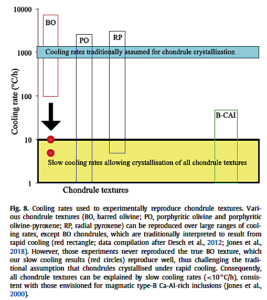Faure, F.; Auxerre, M.; Casola, V.
Earth and Planetary Science Letters, 2022, 593, 117649

Voir en ligne : https://doi.org/10.1016/j.epsl.2022.117649
Abstract :
Barred olivine (BO) chondrules are small ferromagnesian silicate igneous droplets with unique dendritic textures that are considered to have formed in the early solar system during one or more brief high-temperature episodes, followed by rapid cooling in a gas. Rapid cooling rates of 100–7200 ◦C/h during chondrule formation have been proposed based on experiments attempting to reproduce BO crystal textures. However, the BO texture has never truly been reproduced under such rapid cooling conditions. Here, we experimentally show that true BO textures can be produced either after rapid cooling (>50 ◦C/h) following by reheating step or by cooling rates slower than 10 ◦C/h. Regardless of the thermal history considered, the chemical compositions of glass inclusions trapped within olivines of BO chondrules imply a final slow cooling rate one to two orders of magnitude below previous estimates. Such slow cooling rates are consistent with those estimated for plagioclase-bearing porphyritic chondrules and magmatic type-B Ca-Al-rich inclusions, suggesting that slow cooling rates are common to all similar chondritic objects.



